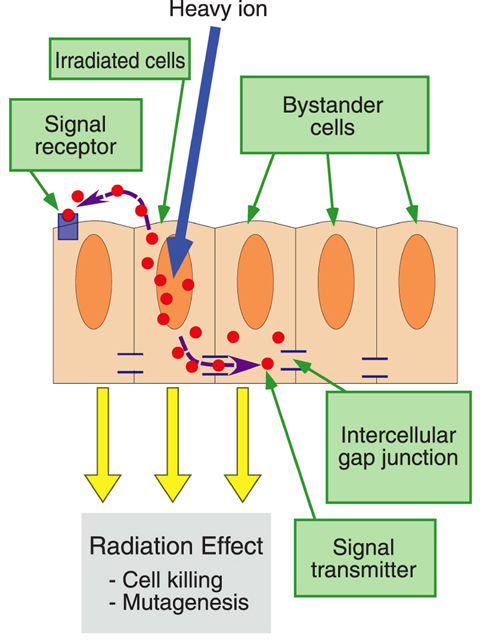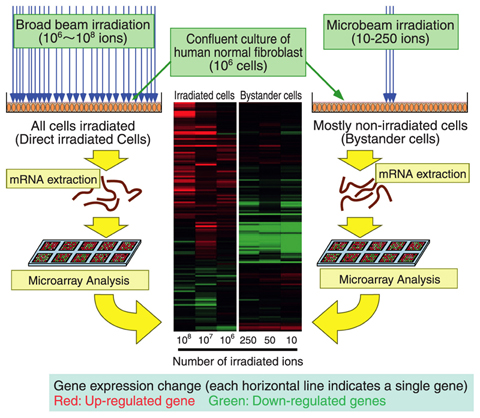
Fig.4-24 Bystander effect

Fig.4-25 Microarray analysis of genes activated in bystander cells
The form and the function of living organisms are the result of the functioning of individual cells and their intercellular communications. Recently, it has become known that such intercellular communication also contributes to the response of living organisms to radiation. In the phenomenon called the "bystander effect", non-irradiated cells neighboring irradiated cells (bystander cells) exhibit radiation effect because they receive a signal transmitter substance from irradiated cells (Fig.4-24).
Heavy-ion beams are utilized for ion beam breeding and for cancer therapy because of its unique biological effectiveness. The elucidation of the mechanisms underlying biological responses to heavy-ion radiation is necessary to advance these useful applications. Analyzing the mechanisms should also contribute the assessment of health risk of space radiation, which includes low-dose heavy-ion radiation. In the cell population irradiated by low-dose of heavy-ion, the contribution of bystander effect becomes large because of an unevenness of dose distribution in the target cell population by low dose heavy-ions. Therefore, we developed a heavy-ion microbeam system in the TIARA facility of JAEA-Takasaki, and have studied the mechanism of cellular response induced by heavy-ion irradiation. This system can irradiate targeted individual cells with a desired number of heavy-ions, and distinguish irradiated cells and non-irradiated bystander cells during a post-irradiation observation period.
Biological responses of irradiated and bystander cells of human normal fibroblast were investigated using a confluent culture of these cells, which has an ability of intercellular communication through gap junctions. The effect in bystander cells was examined using a microbeam irradiation of very limited number of ions (10-250 ions) to irradiate the confluent culture containing approximately 106 cells (Fig.4-25). From the irradiated samples, mRNA was extracted and its gene expression was analyzed using a microarray. Among the gene expressions that showed more than 1.5-fold changes, the genes related to cell cycle or death and cell communication were up-regulated in irradiated cells. On the other hand, a completely different set of genes was up-regulated in bystander cells. Hereafter, we will analyze the roles of these bystander-activated genes in radiation induce cellular communications and so elucidate the effect of low-dose heavy-ion radiation on living organisms.